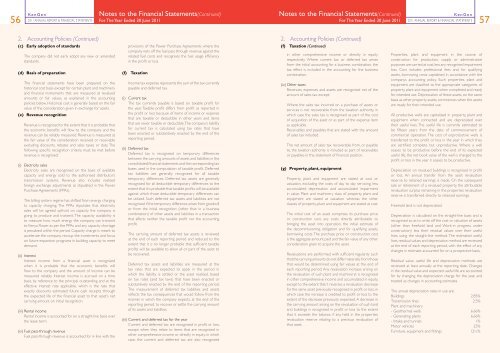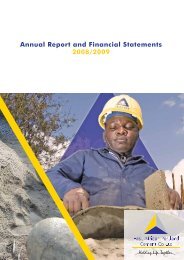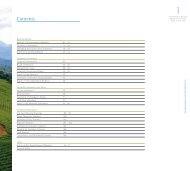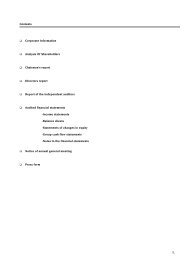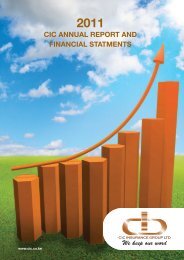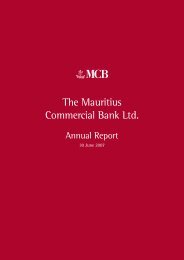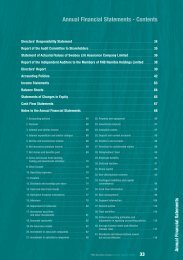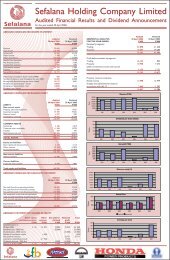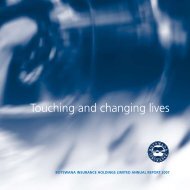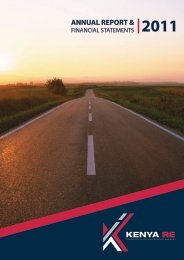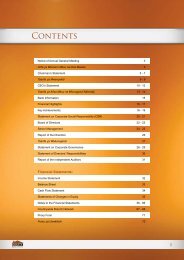2011 Annual Report & Financial Statements - Kengen
2011 Annual Report & Financial Statements - Kengen
2011 Annual Report & Financial Statements - Kengen
Create successful ePaper yourself
Turn your PDF publications into a flip-book with our unique Google optimized e-Paper software.
Notes to the <strong>Financial</strong> <strong>Statements</strong>(Continued)<br />
Notes to the <strong>Financial</strong> <strong>Statements</strong>(Continued)<br />
KenGen<br />
KenGen<br />
56<br />
<strong>2011</strong> ANNUAL REPORT & FINANCIAL STATEMENTS For The Year Ended 30 June <strong>2011</strong><br />
For The Year Ended 30 June <strong>2011</strong> <strong>2011</strong> ANNUAL REPORT & FINANCIAL STATEMENTS<br />
57<br />
2. Accounting Policies (Continued)<br />
2. Accounting Policies (Continued)<br />
(c) Early adoption of standards<br />
The company did not early adopt any new or amended<br />
standards.<br />
(d) Basis of preparation<br />
The financial statements have been prepared on the<br />
historical cost basis except for certain plant and machinery<br />
and financial instruments that are measured at revalued<br />
amounts or fair values, as explained in the accounting<br />
policies below. Historical cost is generally based on the fair<br />
value of the consideration given in exchange for assets.<br />
(e) Revenue recognition<br />
Revenue is recognised to the extent that it is probable that<br />
the economic benefits will flow to the company and the<br />
revenue can be reliably measured. Revenue is measured at<br />
the fair value of the consideration received or receivable<br />
excluding discounts, rebates and sales taxes or duty. The<br />
following specific recognition criteria must be met before<br />
revenue is recognised:<br />
(i) Electricity sales<br />
Electricity sales are recognised on the basis of available<br />
capacity and energy sold to the authorised distributor’s<br />
transmission systems. Revenue also includes realised<br />
foreign exchange adjustments as stipulated in the Power<br />
Purchase Agreements (PPAs).<br />
The billing system regime has shifted from energy charging<br />
to capacity charging. The PPAs stipulates that electricity<br />
sales will be agreed upfront on capacity the company is<br />
going to produce and transmit. The capacity availability is<br />
to measure how much energy the company can transmit<br />
to Kenya Power as per the PPAs and any capacity shortage<br />
is penalized within the period. Capacity charge is meant to<br />
accelerate the company recoup the investments and focus<br />
on future expansion programs in building capacity to meet<br />
demand.<br />
(ii) Interest<br />
Interest income from a financial asset is recognised<br />
when it is probable that the economic benefits will<br />
flow to the company and the amount of income can be<br />
measured reliably. Interest income is accrued on a time<br />
basis, by reference to the principal outstanding and at the<br />
effective interest rate applicable, which is the rate that<br />
exactly discounts estimated future cash receipts through<br />
the expected life of the financial asset to that asset’s net<br />
carrying amount on initial recognition.<br />
(iii) Rental income<br />
Rental income is accounted for on a straight-line basis over<br />
the lease term.<br />
(iv) Fuel pass-through revenue<br />
Fuel pass-through revenue is accounted for in line with the<br />
provisions of the Power Purchase Agreements where the<br />
company nets off the fuel pass through revenue against the<br />
related fuel costs and recognises the fuel usage efficiency<br />
in the profit or loss.<br />
(f) Taxation<br />
Income tax expense represents the sum of the tax currently<br />
payable and deferred tax.<br />
(i) Current tax<br />
The tax currently payable is based on taxable profit for<br />
the year. Taxable profit differs from profit as reported in<br />
the profit or loss because of items of income or expense<br />
that are taxable or deductible in other years and items<br />
that are never taxable or deductible. The company’s liability<br />
for current tax is calculated using tax rates that have<br />
been enacted or substantively enacted by the end of the<br />
reporting period.<br />
(ii) Deferred tax<br />
Deferred tax is recognised on temporary differences<br />
between the carrying amounts of assets and liabilities in the<br />
consolidated financial statements and the corresponding tax<br />
bases used in the computation of taxable profit. Deferred<br />
tax liabilities are generally recognised for all taxable<br />
temporary differences. Deferred tax assets are generally<br />
recognised for all deductible temporary differences to the<br />
extent that it is probable that taxable profits will be available<br />
against which those deductible temporary differences can<br />
be utilised. Such deferred tax assets and liabilities are not<br />
recognised if the temporary difference arises from goodwill<br />
or from the initial recognition (other than in a business<br />
combination) of other assets and liabilities in a transaction<br />
that affects neither the taxable profit nor the accounting<br />
profit.<br />
The carrying amount of deferred tax assets is reviewed<br />
at the end of each reporting period and reduced to the<br />
extent that it is no longer probable that sufficient taxable<br />
profits will be available to allow all or part of the asset to<br />
be recovered.<br />
Deferred tax assets and liabilities are measured at the<br />
tax rates that are expected to apply in the period in<br />
which the liability is settled or the asset realised, based<br />
on tax rates (and tax laws) that have been enacted or<br />
substantively enacted by the end of the reporting period.<br />
The measurement of deferred tax liabilities and assets<br />
reflects the tax consequences that would follow from the<br />
manner in which the company expects, at the end of the<br />
reporting period, to recover or settle the carrying amount<br />
of its assets and liabilities.<br />
(iii) Current and deferred tax for the year<br />
Current and deferred tax are recognised in profit or loss,<br />
except when they relate to items that are recognised in<br />
other comprehensive income or directly in equity, in which<br />
case, the current and deferred tax are also recognised<br />
(f) Taxation (Continued)<br />
in other comprehensive income or directly in equity<br />
respectively. Where current tax or deferred tax arises<br />
from the initial accounting for a business combination, the<br />
tax effect is included in the accounting for the business<br />
combination.<br />
(iv) Other taxes<br />
Revenues, expenses and assets are recognised net of the<br />
amount of sales tax except:<br />
Where the sales tax incurred on a purchase of assets or<br />
services is not recoverable from the taxation authority, in<br />
which case the sales tax is recognised as part of the cost<br />
of acquisition of the asset or as part of the expense item<br />
as applicable<br />
Receivables and payables that are stated with the amount<br />
of sales tax included.<br />
The net amount of sales tax recoverable from, or payable<br />
to, the taxation authority is included as part of receivables<br />
or payables in the statement of financial position.<br />
(g) Property, plant, equipment<br />
Property, plant and equipment are stated at cost or<br />
valuation, excluding the costs of day to day servicing, less<br />
accumulated depreciation and accumulated impairment<br />
in value. Plant and machinery class of property, plant and<br />
equipment are stated at valuation whereas the other<br />
classes of property, plant and equipment are stated at cost.<br />
The initial cost of an asset comprises its purchase price<br />
or construction cost, any costs directly attributable to<br />
bringing the asset into operation, the initial estimate of<br />
the decommissioning obligation and for qualifying assets,<br />
borrowing costs. The purchase price or construction cost<br />
is the aggregate amount paid and the fair value of any other<br />
consideration given to acquire the asset.<br />
Revaluations are performed with sufficient regularity such<br />
that the carrying amounts do not differ materially from those<br />
that would be determined using fair values at the end of<br />
each reporting period. Any revaluation increase arising on<br />
the revaluation of such plant and machineryt is recognised<br />
in other comprehensive income and accumulated in equity,<br />
except to the extent that it reverses a revaluation decrease<br />
for the same asset previously recognised in profit or loss, in<br />
which case the increase is credited to profit or loss to the<br />
extent of the decrease previously expensed. A decrease in<br />
the carrying amount arising on the revaluation of such land<br />
and buildings is recognised in profit or loss to the extent<br />
that it exceeds the balance, if any, held in the properties<br />
revaluation reserve relating to a previous revaluation of<br />
that asset.<br />
Properties, plant and equipment in the course of<br />
construction for production, supply or administrative<br />
purposes are carried at cost, less any recognised impairment<br />
loss. Cost includes professional fees and, for qualifying<br />
assets, borrowing costs capitalised in accordance with the<br />
companys accounting policy. Such properties, plant and<br />
equipment are classified to the appropriate categories of<br />
property, plant and equipment when completed and ready<br />
for intended use. Depreciation of these assets, on the same<br />
basis as other property assets, commences when the assets<br />
are ready for their intended use.<br />
All productive wells are capitalized in property, plant and<br />
equipment when connected and are depreciated over<br />
their useful lives. The useful life is currently estimated to<br />
be fifteen years from the date of commencement of<br />
commercial operation. The cost of unproductive wells is<br />
transferred to the profit or loss in the year in which they<br />
are certified complete but unproductive. Where a well<br />
ceases to be productive before the end of its expected<br />
useful life, the net book value of the well is charged to the<br />
profit or loss in the year it ceases to be productive.<br />
Depreciation on revalued buildings is recognised in profit<br />
or loss. An annual transfer from the asset revaluation<br />
reserve to retained earnings is made. On the subsequent<br />
sale or retirement of a revalued property, the attributable<br />
revaluation surplus remaining in the properties revaluation<br />
reserve is transferred directly to retained earnings.<br />
Freehold land is not depreciated.<br />
Depreciation is calculated on the straight-line basis and is<br />
recognised so as to write off the cost or valuation of assets<br />
(other than freehold land and Work-in progress under<br />
construction) less their residual values over their useful<br />
lives, using the straight-line method. The estimated useful<br />
lives, residual values and depreciation method are reviewed<br />
at the end of each reporting period, with the effect of any<br />
changes in estimate accounted for on a prospective basis.<br />
Residual value, useful life and depreciation methods are<br />
reviewed at least annually at the reporting date. Changes<br />
in the residual value and expected useful life are accounted<br />
for by changing the depreciation charge for the year, and<br />
treated as changes in accounting estimates.<br />
The annual depreciation rates in use are:<br />
Buildings 2.85%<br />
Transmission lines 2.5%<br />
Plant and machinery<br />
- Geothermal wells 6.66%<br />
- Generating plants 6.66%<br />
- Intake and tunnels 1%<br />
Motor vehicles 25%<br />
Furniture, equipment and fittings 12½%


